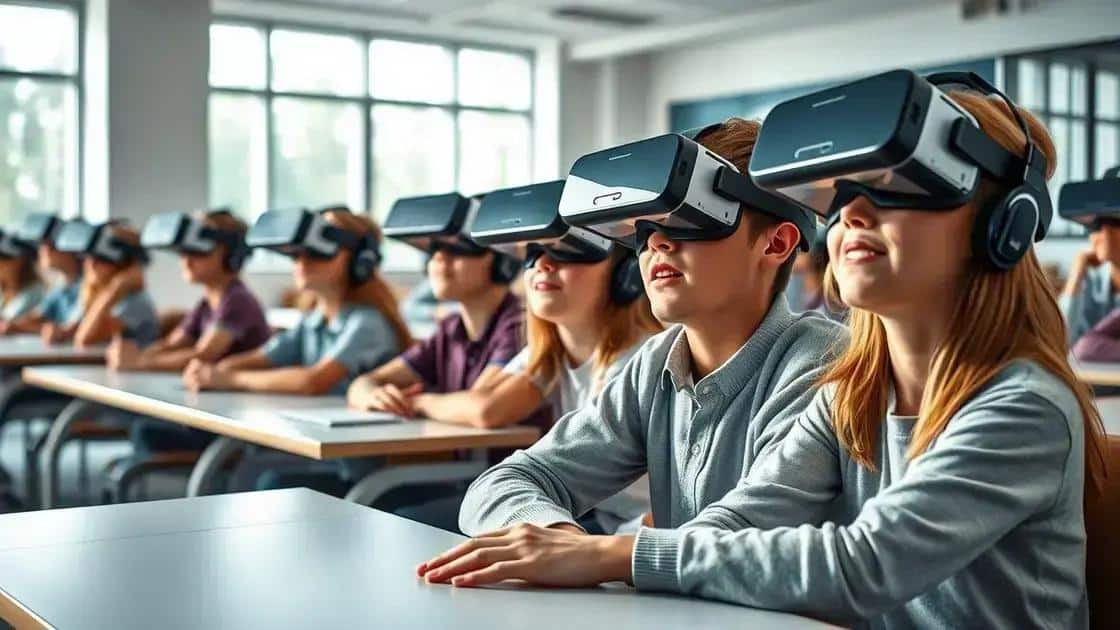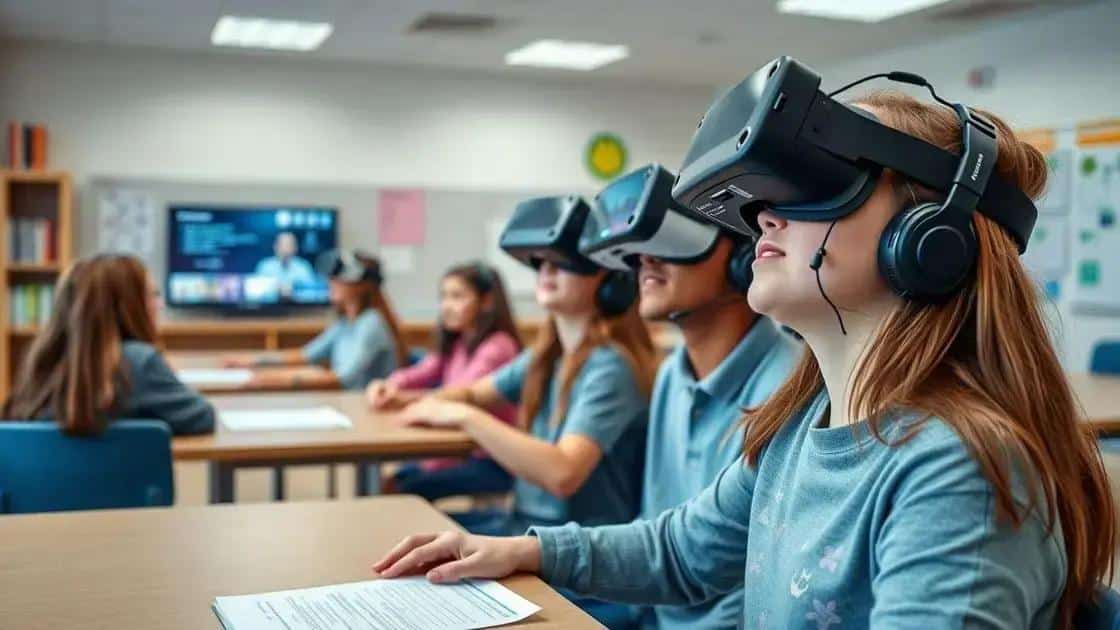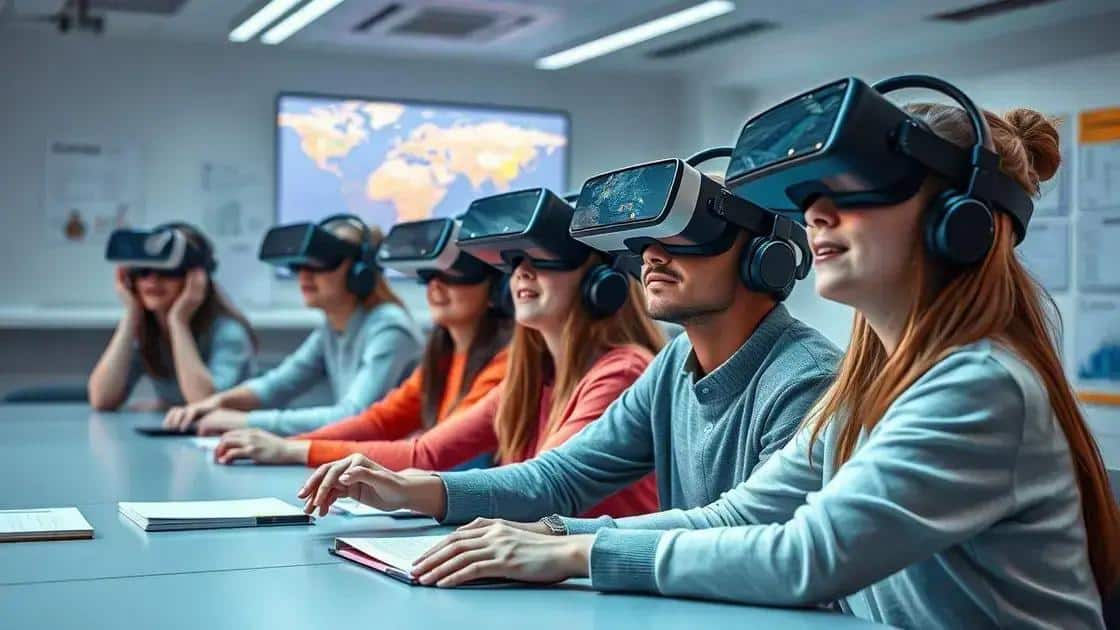Insights on vr learning environments for better education

Insights on vr learning environments reveal that they enhance education through immersive experiences, increased engagement, and personalized learning, despite challenges like costs and technical issues.
Insights on vr learning environments are reshaping the educational landscape. Have you ever wondered how virtual reality can engage students in ways traditional classrooms cannot? Let’s dive into this exciting topic.
Understanding vr learning environments
Understanding vr learning environments is crucial for educators and students alike. These environments use virtual reality to create immersive experiences that enhance learning. With the rise of technology in education, it’s more important than ever to explore how vr can revolutionize the way we learn.
The Concept of VR in Education
At its core, vr learning environments simulate real-world experiences through digital means. This technology allows students to interact with concepts in ways that traditional classrooms cannot. For example, they can explore ancient civilizations or conduct virtual science experiments.
Key Features of VR Learning
- Immersive Experiences: Students feel as though they are part of the learning material.
- Enhanced Engagement: The interactivity keeps learners motivated.
- Personalized Learning: Students can learn at their own pace, revisiting complex topics as needed.
The benefits extend beyond just engagement. Research has shown that students are more likely to retain information if they can experience it firsthand. Imagine studying biology by virtually dissecting a frog or learning history by walking through a digital remake of a historic site. This hands-on learning approach helps solidify understanding and encourages curiosity.
Challenges of Implementing VR
Despite its benefits, there are challenges in adopting vr learning environments. Schools often face budget constraints, which can limit access to necessary technology. Additionally, not all educators are trained to use vr tools effectively, which can hinder the transition to these innovative methods.
As we look toward the future, it’s essential to consider how to overcome these hurdles. Collaboration between technology developers and educators can lead to better tools and training. Moreover, as vr becomes more mainstream, costs are likely to decrease, making it more accessible to schools everywhere.
Benefits of vr in education

The benefits of vr in education are numerous and impactful. By utilizing virtual reality, educators can transform standard lessons into engaging and immersive experiences. This technology offers students a unique way to explore and interact with content, deepening their understanding of complex subjects.
Enhanced Engagement
One of the most significant advantages is the heightened engagement among students. Traditional learning methods can sometimes lead to boredom, but vr learning environments captivate students’ attention. When learners are actively involved, they are more likely to retain information.
- Interactive Learning: VR allows students to participate actively in their education.
- Real-World Simulations: They can explore environments that are otherwise inaccessible.
- Increased Motivation: Virtual experiences stimulate curiosity and a desire to learn.
Another key benefit is the opportunity for experiential learning. With vr in education, students can practice skills in a realistic setting. For instance, medical students can perform virtual surgeries, giving them valuable practice without the risks associated with real-life procedures. This hands-on approach encourages deeper learning and prepares students for their future careers.
Diverse Learning Styles
Virtual reality also accommodates various learning styles. Some students grasp information better through visual or kinesthetic methods. VR environments provide both visual stimulation and the chance to physically interact with elements. This combination caters to different preferences, making learning more inclusive.
In addition to accommodating diverse learners, vr learning environments allow for personalized education. Students can progress at their own pace, revisiting challenging topics when needed. This flexibility supports individual learning pathways, enhancing overall educational experiences.
Challenges in implementing vr technology
Implementing vr technology in education comes with several challenges that schools must address. While the benefits are clear, the road to successful integration is often complex. Understanding these challenges is essential for educators and administrators.
Cost and Budget Constraints
One major challenge is the cost of the technology. Virtual reality headsets and software can be expensive, making it difficult for schools with limited budgets to adopt these tools. Additionally, ongoing maintenance and updates can add further expenses.
- Initial investment: High costs for VR equipment.
- Training costs: Investments needed for teacher training.
- Software updates: Continuous expenses for keeping technology current.
Another significant hurdle is the lack of training for teachers. Many educators may not feel comfortable using new technology, particularly something as advanced as vr technology. Proper training is crucial to help teachers effectively integrate VR into their lesson plans.
Technical Issues and Support
Technical problems can also pose challenges. Schools need reliable internet connections and sufficient hardware to support VR applications. If technology fails during lessons, it can disrupt the learning process and frustrate both teachers and students.
Furthermore, there is often a lack of technical support available in schools. Limited resources for troubleshooting can lead to underutilization of valuable VR tools. This creates a gap between potential benefits and actual learning experiences.
Additionally, educators face concerns about safety and comfort. Not all students may feel comfortable wearing VR headsets for extended periods. It’s important to monitor students’ experiences and ensure they are safe and engaged.
Future trends in vr learning

Future trends in vr learning hold exciting possibilities for educators and students. As technology advances, virtual reality is expected to become an essential tool in classrooms around the world. This shift can lead to more engaging and effective learning experiences.
Increased Accessibility
One trend is the increasing accessibility of vr technology. As the costs of VR headsets and software decline, more schools will be able to implement these tools. This will allow students from different backgrounds to benefit from immersive learning experiences, creating a more equitable education system.
- Affordable devices: Companies are developing cheaper VR headsets.
- Mobile VR: Smartphones can power VR experiences, reducing additional costs.
- Cloud-based solutions: Streaming VR content will require less powerful hardware.
Another promising trend is the development of content tailored to specific educational needs. As more educators experiment with vr learning, developers will create applications that meet diverse curricular goals. This custom content will enhance the effectiveness of lessons.
Collaborative Learning Environments
The evolution of vr technology also fosters collaborative learning. Virtual reality platforms will allow students to interact with peers in real-time, regardless of their physical location. Imagine a class where students from different countries work together to complete projects in a shared virtual space.
This approach not only promotes teamwork but also exposes students to different cultures and perspectives. Furthermore, gamification is another trend that will shape the future of VR in education. By incorporating game-like elements into the learning process, students will stay motivated and engaged.
As VR learning evolves, we can also expect advancements in assessment methods. Educators will have access to better tools for tracking student progress in immersive environments. This data can inform teaching strategies and improve overall educational outcomes.
FAQ – Frequently Asked Questions about VR Learning Environments
What are the main benefits of using VR in education?
The main benefits include enhanced engagement, immersive experiences, and personalized learning opportunities for students.
What challenges do schools face when implementing VR technology?
Schools often face budget constraints, lack of teacher training, and technical issues that can impede the use of VR.
How can VR technology improve student outcomes?
VR can improve student outcomes by providing hands-on experiences that deepen understanding and retention of information.
What future trends can we expect in VR learning environments?
Future trends may include increased accessibility, tailored content for diverse educational needs, and enhanced collaborative learning experiences.





